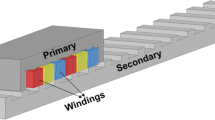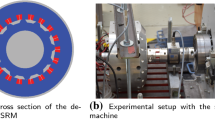Abstract
This paper presents a simple turn-on and turn-off angles adjustment method to increase the efficiency of small-size switched reluctance motor (SRM) in wide speed and torque range. The simplicity of the control algorithms allows building a variable speed drive without a high-performance microcontroller and FPGA or ASIC. The firing angles calculation uses a second-order polynomial and look-up table. An increase in efficiency is demonstrated on the finite element analysis (FEA) model of SRM which was verified against measurement on an experimental test bench. Measured efficiency maps have a flat top for the investigated motor. Therefore, the angle jittering due to limited position sensor precision and 50 µs processor cycle time have a small impact on motor efficiency. The evaluation of the angle adjustment method and comparison with measurements identifies which part of the FEA model is crucial for the one-to-one implementation of the angle adjustment formulas obtained from simulation to the motor control algorithm.





















Similar content being viewed by others
References
More A (2019) Switched Reluctance Motors Market 2019 Industry Size by Global Major Companies Profile, Competitive Landscape and Key Regions 2025. 360 Research Reports. https://www.theexpresswire.com/pressrelease/Switched-Reluctance-Motors-Market-2019-Industry-Size-by-Global-Major-Companies-Profile-Competitive-Landscape-and-Key-Regions-2025-360-Research-Report_10273615. Accessed 24 November 2019.
Tursini M, Villani M, Fabri G, Di Leonardo L (2017) A switched-reluctance motor for aerospace application: design, analysis and results. Electric Power Syst Res 142:74–83. https://doi.org/10.1016/j.epsr.2016.08.044
Evangeline JS, Kumar SS, Jayakumar J (2016) Torque modeling of switched reluctance motor using LSSVM-DE. Neurocomputing 211:117–128. https://doi.org/10.1016/j.neucom.2016.02.076
Belhadi M, Krebs G, Marchand C, Hannoun H, Mininger X (2018) Geometrical optimization of SRM on operating mode for automotive application. Electr Eng 100(1):303–310. https://doi.org/10.1007/s00202-016-0504-0
Dúbravka P, Rafajdus P, Makyš P, Szabó L (2017) Control of switched reluctance motor by current profiling under normal and open phase operating condition. IET Electr Power Appl 11(4):548–556. https://doi.org/10.1049/iet-epa.2016.0543
Du L, Gu B, Lai JS, Swint E (IEEE, Control of Pseudo-Sinusoidal Switched Reluctance Motor With Zero Torque Ripple and Reduced Input Current Ripple. 2013 IEEE Energy Conversion Congress and Exposition (Ecce) 3770-3775, Denver, CO. doi:https://doi.org/10.1109/ECCE.2013.6647200
Zhang M, Bahri I, Mininger X, Vlad C, Xie HQ, Berthelot E (2019) A new control method for vibration and noise suppression in switched reluctance machines. Energies 12(8):16. https://doi.org/10.3390/en12081554
Cheng H, Chen H, Yang Z (2015) Average torque control of switched reluctance machine drives for electric vehicles. IET Electr Power Appl 9(7):459–468. https://doi.org/10.1049/iet-epa.2014.0424
Fuengwarodsakul NH, Menne M, Inderka RB, De Doncker RW (2005) High-dynamic four-quadrant switched reluctance drive based on DITC. IEEE Trans Ind Appl 41(5):1232–1242. https://doi.org/10.1109/TIA.2005.853381
Gan C, Wu J, Sun Q, Kong W, Li H, Hu Y (2018) A review on machine topologies and control techniques for low-noise switched reluctance motors in electric vehicle applications. IEEE Access 6:31430–31443. https://doi.org/10.1109/ACCESS.2018.2837111
Murugan LS, Maruthupandi P (2020) Sensorless speed control of 6/4-pole switched reluctance motor with ANFIS and fuzzy-PID-based hybrid observer. Electr Eng 102:831–844. https://doi.org/10.1007/s00202-019-00915-5
Sovicka P, Rafajdus P, Vavrus V (2020) Self sensing control of switched reluctance drive with sliding mode observer using phase voltage calculation. In: 2020 International symposium on power electronics, electrical drives, automation and motion (SPEEDAM), Sorrento, Italy, pp. 716–721, doi: https://doi.org/10.1109/SPEEDAM48782.2020.9161948
Heins G, Thiele M, Brown T (2011) Accurate torque ripple measurement for PMSM. IEEE Trans Instrum Meas 60(12):3868–3874. https://doi.org/10.1109/TIM.2011.2138350
Hossain S, Smith D, Gebhart S, Deshpande U (2005) Torque ripple tester for a permanent magnet synchronous motor. IEEE Int Conf Elect Mach Drives, San Antonio, TX 2005:1020–1024. https://doi.org/10.1109/IEMDC.2005.195847
Pouramin A, Dutta R, Farshadnia M, Rahman MF (2020) A standstill method to measure electromagnetically induced torque ripple of permanent magnet synchronous machines. IEEE Trans Instrum Meas 69(10):7627–7635. https://doi.org/10.1109/TIM.2020.2983528
Hamouda M, Számel L (2018) Reduced Torque Ripple based on a Simplified Structure Average Torque Control of Switched Reluctance Motor for Electric Vehicles. 2018 International IEEE Conference and Workshop in Óbuda on Electrical and Power Engineering (CANDO-EPE), Budapest, pp. 109–114. doi: https://doi.org/10.1109/CANDO-EPE.2018.8601133.
Bober P, Ferkova Z (2020) Comparison of an off-line optimized firing angle modulation and torque sharing functions for switched reluctance motor control. Energies 13(10):2435. https://doi.org/10.3390/en13102435
Song S, Fang G, Hei R, Jiang J, Ma R, Liu W (2020) Torque ripple and efficiency online optimization of switched reluctance machine based on torque per ampere characteristics. IEEE Trans Power Electron 35(9):9608–9616. https://doi.org/10.1109/TPEL.2020.2974662
Zgodavova K, Zolotova I, Roznik J (2011) Creative laboratory engineering education at technical faculties (The pilot project). In: 14th International conference on interactive collaborative learning, Piestany, pp. 632–636, doi: https://doi.org/10.1109/ICL.2011.6059663
Acknowledgements
This work was supported by the Slovak Research and Development Agency under contract No. APVV-18-0436 and APVV-15-0750.
Author information
Authors and Affiliations
Corresponding author
Additional information
Publisher's Note
Springer Nature remains neutral with regard to jurisdictional claims in published maps and institutional affiliations.
Rights and permissions
About this article
Cite this article
Bober, P., Ferková, Ž. Firing angle adjustment for switched reluctance motor efficiency increasing based on measured and simulated data. Electr Eng 104, 191–202 (2022). https://doi.org/10.1007/s00202-021-01346-x
Received:
Accepted:
Published:
Issue Date:
DOI: https://doi.org/10.1007/s00202-021-01346-x




